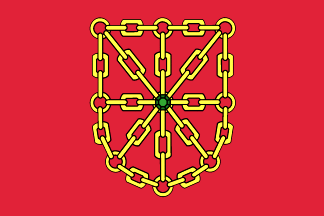

Last modified: 2025-01-04 by olivier touzeau
Keywords: basse-navarre | basque country | iparralde | navarre | navarra | coat of arms (chains: yellow) | chains | emerald |
Links: FOTW homepage |
search |
disclaimer and copyright |
write us |
mirrors
Flag of Lower Navarre - Image by Olivier Touzeau, 4 June 2022
See also:
When the southernmost part of the Kingdom of Navarre was annexed by Spain (1515), the legitimate heirs of the Navarre royal family retained the title and withdrew to the Lower Navarre territory, north of the Pyrenees. They ruled a kingdom united with neighbouring Béarn. When King Henry III of Navarre was crowned King of France as Henry IV, he took the title of "King of France and Navarre", kept by his successors until the French Revolution.
Lower Navarre is also one of the three provinces of Iparralde, the Northern Basque Country (located in France).
Ivan Sache, 13 September 2009
Geographically, Lower Navarre is integrated into the great communication route from the west of the Pyrenees corresponding to the zone of influence of the Saint-Palais (Donapaleu) - Saint-Jean-Pied-de-Port (Donibane Garazi ) which continues south, via Roncevaux/Orreaga and Pamplona/Iruña. Lower-Navarre (French: Basse-Navarre; Basque: Nafarroa Beherea), until 1789 nominally Kingdom of Navarre, covers 1,284 km² ans is one of the three historic provinces in the north-east of the traditional Basque Country.
Just like the historical territories of the southern Basque Country in Spain (Alava, Biscay, Guipuzcoa and Navarre), the historical territories of the the northern Basque Country (Lower-Navarre, Labourd and Soule) had “regional forums" which represented the autonomy of these territories. These forums were abolished on the night of August 4, 1789, in the midst of the French revolutionary ferment. These regional assemblies, made up of delegates from each commune, excluded or limited the power of the privileged people of the time, namely the nobility, the nascent bourgeoisie and the clergy. During the division of France into departments, in 1789, proposals to create a Basque department, in particular by Dominique Garat, were not followed up and on March 4, 1790, the three provinces were grouped together with Béarn and with the Gascon lands of Bayonne and of Bidache and Soubestre to form the department of Basses-Pyrénées, now Pyrénées-Atlantiques.
Olivier Touzeau, 4 June 2022
The flag of Lower Navarre is red with the chains taken from the coat of arms of Navarre.
The chains of Navarre are traditionally explained" by the legend of a king who cut and tied up with his sword the chains protecting a Moors' camp and, subsequently placed them on his red shield.
Pascal Vagnat, 28 August 1997
The pattern is generally red with the main element of the coat of arms in the center, as observed:
Olivier Touzeau, 4 June 2022
Variant flag
Flag of Lower Navarre - Image by Pierre Gay, 28 August 1997
Simplified flag of Navarre - Image by Ivan Sache, 12 July 2009
Stage 9 of Tour de France (Saint-Gaudens-Tarbes, 160 km) crossed on 12
July the legendary Col du Tourmalet (2,115 m asl). As usual in the
Pyrenees, most supporters' flags came from neighbouring Spain, indeed
very few Spanish national flags but bunches of Basque, Asturian and
Catalan flags.
A flag displayed close to the top of Tourmalet looks
like a simplified, stylized version of the flag of Navarre, that is with the chains replaced by lines.
Ivan Sache, 12 July 2009